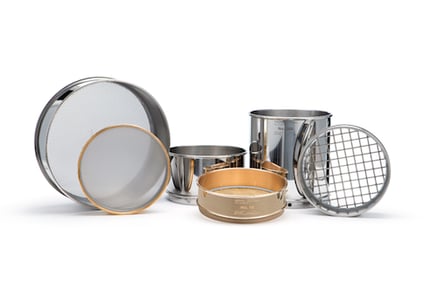The Ways Test Sieves Are Marked for Identification
Whether used for hand sieving or test sieve analysis, test sieves are among the most recognizable particle analysis instruments in today's market. In fact, their reputation of dependability and accuracy has landed them in dozens of industry standards.
But to the point of accuracy, obtaining reliable particle analysis results when using test sieves relies on lab operators using the suitable sieves at the right point of the process. That said, most if not all sieves are marked for identification.
But why exactly are test sieves marked for identification, and what does test sieve labeling look like?
Here at W.S. Tyler, test sieve analysis, particularly quality test sieves and the industry-leading RO-TAP Sieve Shaker, is our bread and butter. We use our years of experience to help lab operators make heads or tails of the many pieces of equipment needed to yield the results they desire, offering a sigh of relief.
To make worries associated with using the wrong test sieves when testing sample material a thing of the past, this article will be covering:
- What a test sieve is
- Why test sieves are labeled
- How test sieves are labeled
- How test sieve identification labels affect the cost
What Is a Test Sieve?
A test sieve is a traditional piece of particle analysis equipment that utilizes a screening media to separate particles of a material sample to determine the average size of the particle and the overall quality of a production line. In most cases, this screening media is woven wire mesh; however, other material, such as perforated plate, can be employed.

To that end, when woven wire mesh is used, an opening range of 4" (100mm) to 635 mesh (20um) is achievable. Regardless of which screening specifications you use, it is critical that you are aware of these specifications when testing.
Why Label Test Sieves?
The ASTM E11 and ISO 3310-1 Standards for Test Sieves have rules for the identification of Test Sieves. Both Standards dictate that all test sieves must be marked with the nominal aperture size, the standard with which it complies, the name of the supplier, and have a unique serial number.
Any reputable test sieve should carry these details at the minimum. The ISO standard also requires the frame and mesh material to be included, while the ASTM standard allows for the option of including the certification level to be marked as well.
How Are Test Sieves Labeled?
Various test sieve manufacturers use different methods to include this required information on the test sieves they provide. We've described these options below.
Laser Mark
This method uses a laser to create a permanent mark on the test sieve frame. Laser markings stand up to quite a lot of abuse and remain clear and legible after many, many uses and washing.
W.S. Tyler has been marking our test sieves in this manner for the last ten years. Test Sieves manufactured back in that time frame coming back to us for recertification of the mesh show the laser mark identification remains clear on sieves after all this time.
Metal Nameplate
This method affixes a painted plate to the test sieve frame using rivets. The identification information is either pin stamped or laser marked on the plates.
This type of identification was the most widely used for many years, and the bulk of all of the test sieves in use today have a metal nameplate.
Stickers
Heavy-duty stickers can be printed and affixed to the test sieve frames for identification purposes. After repeated use and washing, their glue can begin to wear down, and the stickers can begin to peel away.
This creates a risk of not being able to identify the correct mesh on a test sieve.
Do Test Sieve Labels Affect the Cost of the Test Sieve?
The label that is placed on your sieve, in most cases, will have no impact on the cost of the sieve. That said, the type of sieve, sieve alloy, mesh specifications, sieve size, and any sort of certification required will ultimately dictate the cost of your test sieves.
To learn more about the cost of a test sieve, read the following article:
Get To Know How You Can Translate the Specifications on Your Label
Test sieves receive a label after being assembled to indicate the specification of the sieve as required by ASTM and ISO standards. Depending on the sieve and the sieve manufacture, this label can take the form of either a laser engraving, metal nameplate, or sticker.
Regardless of how your sieves are labeled, having the ability to convert your sieve specifications between both ASTM and ISO designation is critical. While this may seem daunting, there are tools, such as the standard metric and U.S. sieve cloth table, put in place to make this a painless process.
W.S. Tyler has spent over 140 years perfecting how we guide customers' approaches to implementing test sieves that comply with industry standards. Part of this approach is educating you on how ASTM and ISO sieve designation communicates with one another.
To that end, we wrote the following article not only to define what the standard metric and U.S. sieve cloth table is but how to use it as well:
About Ronnie Brown
Ronnie is the Content Writer for W.S. Tyler and has four years of experience as a professional writer. He strives to expand his knowledge on all things particle analysis and woven wire mesh to leverage his exceptional writing and graphic design skills, creating a one-of-a-kind experience for customers.




